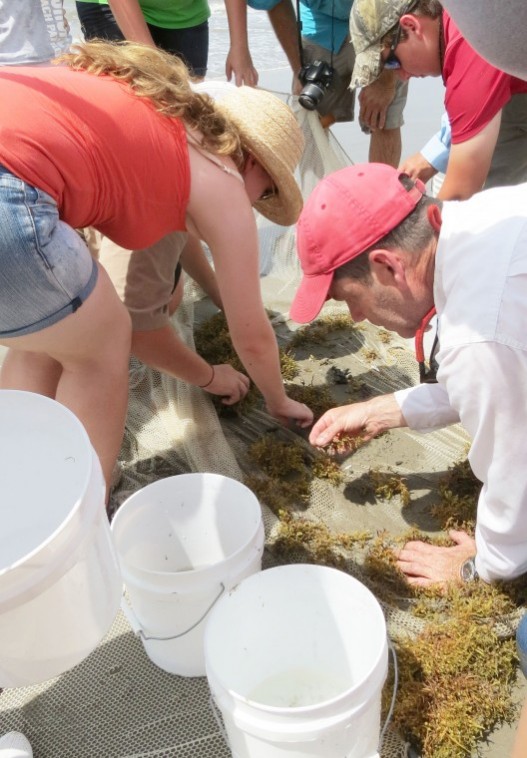
HTHA launches investigation into alleged director misconduct
August 1, 2012CRIME BLOTTER: Reported offenses in the Tri-parishes
August 1, 2012Fifteen high school students got a close view of the effects of coastal erosion and possibly were the last to ever touch the sands of Wine Island. It was all part of Louisiana Universities Marine Consortium Estuarine Awareness and Discovery camp.
“Today, we will be visiting Wine Island, a fragile little barrier island that is almost gone,” said Dr. Gary Lafleur Jr., an associate professor of biological sciences at Nicholls State University, as he briefed students before boarding boats to the island. “There are no trees, no grass. It’s on its last leg. This may be its last year. One more bad storm may wipe it out.”
The island is one of five that make up the Isle Dernieres Barrier Island Refuge, and special permission from the Louisiana Department of Wildlife and Fisheries must be obtained before setting foot on the island. More then 150 years ago, the five islands – Trinity, Raccoon, East, Whiskey and Wine – were part of one large mass called Last Island, a popular resort location in the 1850s. Students also visited Trinity, the largest of the five islands.
The weeklong camp, geared toward students interested in marine biology, featured a canoe trip through the salt marsh, dissection and plankton labs, plant and animal population surveys and beach surveys.
Prior to launching from LUMCON, Lafleur asked students what their favorite organisms were, garnering a variety of answers ranging from a mallard and striped bass, to a Catahoula leopard dog and a bottlenose dolphin, to a panda bear and a blanket octopus.
“As soon as we get on the boat, I want you to observe how the habitat transitions from one to another as we head farther south, from salt marsh to barrier islands,” Lafleur said. “This is the real wilderness. A barrier island is planted by Mother Nature. This is natural zonation. The area that surrounds your home was landscaped by someone.”
In the 10-mile journey from Cocodrie to the island, organisms such as smooth cord grass, or oyster grass, gave way to black mangrove trees.
“There is still freshwater here in the area,” Lafleur said. “The snails in the marsh, marsh periwinkles, will change to zebra periwinkle, which can usually be found on rocks on the barrier islands. Barrier islands and marsh plants and animals have cousins who are the same but not. It’s all part of speciation [a process of evolution that leads to new species].”
While en route to Wine Island, Murt Conover, LUMCON marine education associate and aquarist, had boat captains pull over in a large area sargassum, a free-floating seaweed, so that students could collect organisms from the mass.
“The seahorse that is at LUMCON came from a patch of sargassum,” Conover said as students leaned over the edge of the boat and scooped several small crabs from the water. “Put them back on top of the grass. That is where they live.”
As the boat convoy pulled up to Wine Island, the only indication that land was within sight was a large flock of brown pelicans making a small plot of sand their parking spot.
“It will only take 20 minutes to walk all the way around the island,” Lafleur said as students tested the salinity of the water in the surf.
On the short journey around the island, campers stopped at an area on the isle’s western bank that was littered with feathers, trash, fishing gear, plant debris and even a pelican egg, evidence previous day’s high tide.
“These items are called flotsam and jetsam,” Lafleur said. “The egg probably washed up here during the last storm. It’s no longer a good egg. It should be in a nest.”
Several students were saddened to know that the egg would never produce a baby bird. Other than the pelicans, the island’s only other visible signs of life included a few sparse patches of vegetation.
“Those are some tough plants, they are first colonizers,” Lafleur said. “See those three small lagoons in the middle of island? Those are not a good sign. They make it easier for the wave action to break through the island because there is no dune. Sometimes rocks are used to help keep an island from eroding, but rocks are not always a good way to keep them in place. An island has literal drift, and a living island always moves over time.”
Soon the visit ended, and students waded to waiting boats for their journey to Trinity Island.
“Here, you will see three different habitats,” Lafleur said as the boats arrived via a canal on the north side of the island. “On the seaward side, you will see the high-energy habitat that experiences more wind and more surf. The plants and animals that live there have adapted to the environment. The second and middle area is the dune area and the third is the leeward, marsh side of the island, which is the low-energy side.”
Campers quickly made their way to the Gulf side of the island, excited to begin more observing.
“I’ve worked at LUMCON before, and I want to be a marine biologist,” said Tori Hebert, a sophomore at Terrebonne High School, as she and Lafleur, Kaylee Gleason, a senior at Live Oak High School, Sarah Simoneaux and Elizabeth Click, both juniors at South Terrebonne High School, and Callee Rome, a senior at Louise S. McGehee in New Orleans conducted a beach profiling exercise by measuring the island elevation.
“It’s a great way to gain knowledge,” Hebert said. “I’ve been to other marine biology camps, and I really like this one because we are learning about the barrier islands. Hopefully, we can keep future generations interested in their protection.”
Although Hebert is not sure about which area she would like to focus her future marine biology studies, the camp’s plankton studies certainly got her interested in environmental and species protection.
“We learned how pollution changes the water and the plants in it,” Hebert said.
Caty Thibodeaux, a sophomore at Central Lafourche High School, also found the plankton and water projects interesting.
“We took plankton samples while on board the Acadian [LUMCON’s research vessel,” Thibodeaux said. “We came back the lab, put it in dishes and looked at it under microscope. It was really cool to see.”
“Everything is so cool,” Gleason said. “I can’t pick a favorite thing we have done so far.”
After completing the land study portion of their barrier island project, Lafleur, Conover and Joe Dantin with the Barataria-Terrebonne National Estuary Program gave students a quick demonstration on using a seining net and how to do the “stingray shuffle.”
“Don’t pick up your feet when you walk in the water,” Lafleur said, laughing. “Just slide your feet. If you pick up your feet and step on a sting ray, it will not be good.”
Students formed three groups and headed out into the Gulf water, catching pompano, shad and leather jacket fish, small shrimps and crabs and even a baby shark.
“Barrier islands like these provide good nursing ground for young fish,” Lafleur said as he helped students collect marine life from the nets. Students took notes jotted down notes about the animals before returning them to the water.
“I like everything about being outside,” said Gavin Goolsby, a junior at Houma Christian. “I like the boat rides and the chance to see the barrier islands, marsh and open water up close. I also like learning about the different marsh grasses and other vegetation. I didn’t know the names of many of them before camp.”
Many of the students were questioned where the next island stop would be as they returned to the boats, but Trinity would be the last leg of this trip, marking a return to LUMCON.
“The barrier island trip is new to the camp itinerary,” Conover said. “I hope to continue it at future camps, but it just depends on the funding. This year’s camp was funded by the Southern Oil and Gas Invitational.”
Even though the adventure appeared over, a pod of about seven dolphins, one with a calf, surfaced on the trip back to LUMCON, and students quickly pulled out their cell phones and cameras for one last photograph from the day.












